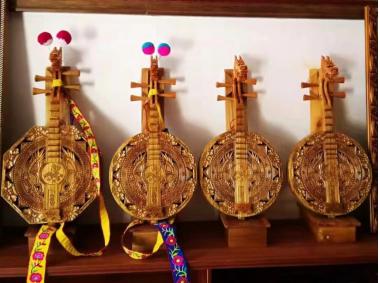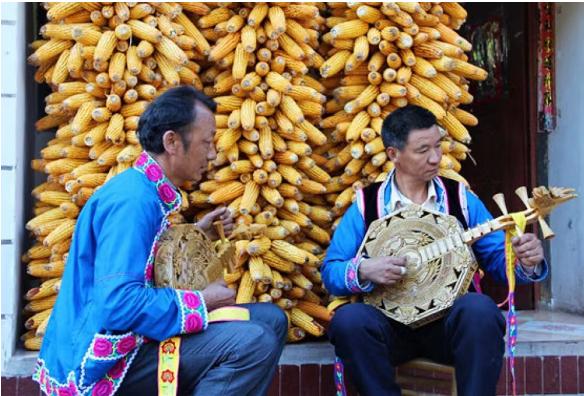Intangible cultural heritage "artist" Li Shuming guards "original intention" with "ingenuity"
The breeze blew the treetops and walked into the quaint wooden house. The house was silent and silent, except for the rustling of sawdust falling from the boards. Li Shuming, a villager in Chahe Village, Longchuan Town, Nanhua County, was busy at an old table. , the carving knife slashed the wooden board, and Junxiu's pattern gradually took shape.
Li Shuming, Yi nationality, born in August 1963, is a native of Chahe Village, Longchuan Town, Nanhua County. He has been engaged in making Yueqin for more than 30 years. In 2010, he was named as the fourth batch of inheritors of intangible cultural heritage in Yunnan Province. In 2021, he was selected as the third batch of "Yi Township Talents" in Chuxiong Prefecture, and was selected as "Yi Township Famous Craftsman".
Zhennan Yueqin, one of the traditional musical instruments of the Yi nationality, is named for its shape like a full moon and a crisp sound like a qin. Zhennan Yueqin has a long history. It was recorded as early as the Song Dynasty "Le Book", and it was famous in the Qing Dynasty. It was recorded in Guangxu's "Zhennan Zhou Zhi": "The harmonica and Yueqin Zhou people, Yang's family, have a history of their own business, and they are all made. There are beautiful voices, and there are many people in the city.”

Chahe Village, Longchuan Town, Nanhua County, is an ethnic minority village with strong ethnic customs. Li Shuming grew up in Chahe Village. He was good at blowing, pulling, playing, and singing when he was a child. His parents were carpenters, so he naturally became interested in Yueqin making. Li Shuming introduced that the Zhennan Yueqin mainly uses catalpa wood and water wax gourd wood as raw materials, and then uses the tenon and tenon method and the glue method to make the piano cavity, piano rod, headstock, string hairpin, and string products respectively. It is made by more than 10 steps such as coloring, winding, and arranging. It often takes more than a month to make a Yueqin, which most tests the patience of the craftsman.
"The most important thing in making Yueqin is to be calm. Sometimes I have to sit for ten hours a day from morning to night. I'm getting old and my eyes can't see clearly. Many young people can't bear this hardship, and naturally they don't want to follow along." Li Shuming said.

During the more than 20 years of making Yueqin, Li Shuming guarded his "original intention" with "ingenuity". He devoted himself to research, and the carved patterns range from primitive totems to the sun, moon and stars, flowers, birds, fish, grass, mountains and trees, all of which are symbols of minority cultures. In 2006, the craftsmanship of Zhennan Yueqin was listed as an intangible cultural heritage in Yunnan Province. In 2010, Li Shuming took Zhennan Yueqin to Beijing to participate in the first Chinese Peasant Art Festival, and was named "Excellent Works of Chinese Peasant Art Festival". In 2011, Zhennan Yueqin was exhibited at the Shanghai World Expo, and the beauty of national culture bloomed brilliantly. In 2015, Li Shuming was commended as "the representative inheritor of the outstanding intangible cultural heritage project of Chuxiong Prefecture". In 2021, Li Shuming was selected as a "Famous Craftsman in Yi Township", and successively established Zhennan Yueqin Skills Training Institute and Li Shuming Yi Township Famous Craftsman Studio, and received special subsidy funds. Zhennan Yueqin is not only an ordinary traditional musical instrument of ethnic minorities, but also a beautiful handicraft and a popular tourist product. The craftsmanship of Yueqin is protected through inheritance and developed through innovation, gradually moving out of the "small mountain village" and toward the "big world". Li Shuming pointed to the cabinets full of certificates and trophies and said proudly, "With this craft, I am a little famous, and it has added a lot of income to my family. The Yueqin I have been to has gone places more than I have been to. There are more. The national culture is our root, and I dare not forget it, nor can I forget it.”

Today, the size of the studio has gradually expanded, and the organizational structure has become clearer. The protection and inheritance of Zhennan Yueqin has a professional team responsible for processing, research and development, and promotion, creating a "brand + project + inheritor + product + tourism" literature. The new model of integrated development of tourism, agriculture and business has polished the rural tourism business card of "Red Miyilu, Duozi Chahe Village".
The Chahe River in late spring, the green hills towering green, the fields blooming, and the melodious sound of the melodious Yueqin rang. In the rubbing of time, Li Shuming engraved his expectations for a better life on the Yueqin with his hard-working hands, leading the inheritance of skills, strengthening the development of industries, and driving the villagers to become rich. A small Yueqin played the song of happiness for the people of Yi Township in the new era.
 渝公网安备 50010702504639号
渝公网安备 50010702504639号